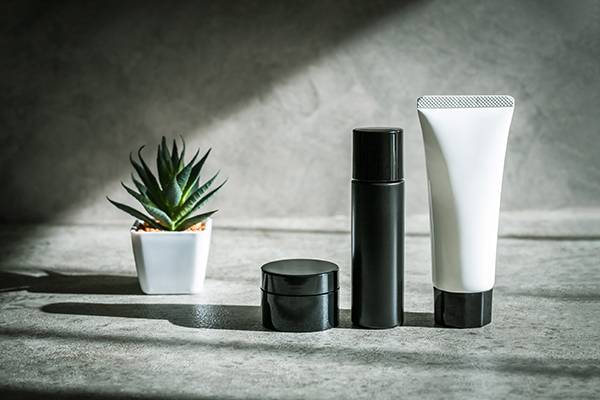
Recently, there have been more opportunities to see TV commercials and advertisements for men's cosmetics. At ISETAN Shinjuku, there is a dedicated sales floor for men's cosmetics, indicating the high level of attention. This time, we investigated men's beauty awareness and use of cosmetics, including a comparison with women.
First, let us look at actions related to beauty that took place within six months (Figure 1). The most common action among men was face-washing with facial washing foam, which was practiced by more than 40% of men. Looking at overall actions for beauty, more than half of all men practice some kind of them. The rate of using facial washing foam at least once a day was highest among men in their 40s, followed by those in their 50s (Figure 2). More than 30% of men in most age groups do this.
The rate of men in their 20s who answered that they spend more than \2,000 per month on cosmetics was also high (Figure 4). This is only different by a few percent compared to that of women in the same age group, indicating that men in their 20s are close to women in terms of the amount of cosmetics they purchase.
Next, we looked at awareness toward beauty. When comparing the level of interest in skincare by gender, the rate of men in their 20s who answered that they were "very interested" was about the same rate as that of women of the same age. Including those who answered "fairly interested," it turns out that more than 40% of men in their 20s are interested in skin care (Figure 5).
The percentages of participants who thought that "it is better for men to have clean skin" and "it is not strange for men to take care of their skin" were higher, at more than 40% for men and 60-70% for women. It indicates that many women are more positive about men taking care of their skin (Figure 6).
The percentage of men in their 20s who think "it benefits my personal/business relationships" with regard to skin care was particularly high, at over 40%, higher than that of women in the same age group (Figure 6). A comparison among men as a whole shows that men in their 20s and 30s are particularly aware of this.
Although there are differences between men and women in terms of beauty awareness, it suggests that the number of men in their 20s who believe it is beneficial for men of all ages to practice skincare is growing.
Next, we looked at cosmetics used within a month and how their frequency changed compared to a year ago. As a result, the "total of those who increased the frequency of cosmetics use" for men was significantly higher than that for women in all seven categories, indicating that the number of men using cosmetics has increased within this year. Especially for cleansing, the growth rate exceeds 50%, which is the highest (Figure 7). It is speculated that this is due to the fact that more and more men are using cosmetics, not just shaving lotions, which have been the mainstay of men's skin care until now. Although it is still fewer than women, it suggests that the market may grow in the future.
The majority of men in their 20s who took actions for beauty chose "to have beautiful skin" as their reason for doing so (Figure 8). It also shows that those in their 20s are influenced by the people around them and celebrities. Men in their 40s and older selected "because I value cleanliness" at a higher rate than women. Men in their 30s were the most likely to seek anti-aging benefits, with about half of them seeking such benefits, the highest rate of any gender and age, including women.
Next, at the current cosmetics user base, we looked at the brands they use and the reasons for their choices. "Kao Biore," "SHISEIDO UNO," and "mandom GATSBY," which are well-established cosmetics for men, were among the top sellers. Of note here is that "SHISEIDO ELIXIR," a widely known brand for women, is also in 5th place. It is also ranked 6th as a brand they would like to purchase in the future, indicating that they would like to use not only brands for men. As a reason for choosing a brand, a good corporate image was the most important factor for men, more than twice as many as for women.(Figure 11). In addition, "technological capabilities," "top share," and "advertising and models for promotion " were higher than women.
It is thought that men's traditional image of the brand they already have and a sense of security in using the brand they have always used are more important factors in their choice of cosmetics brands than cosmetics cost and functionality, which are the most important factors for women.
The market for men's cosmetics is expected to grow in terms of both variety and size in the future, given the high level of beauty awareness among men in their 20s, the increasing awareness of cleanliness among men in their 30s and beyond, and the growing interest in anti-aging.
Translating articles
- 6.9 Trillion Yen Market Created By Women― Will Afternoon Tea save the luxury hotels in the Tokyo Metropolitan Area
- The Penetration of Premium Beer, and a Polarization of the Growing Beer Market
- Frozen Foods' Benefits Are Expanding, and Child-raising Women Are Driving Demand
おすすめ新着記事

成長市場を探せ キャッシュレス決済のなかでも圧倒的なボリュームを誇るクレジットカード決済は、2024年、3年連続の2桁成長で過去最高を連続更新するとともに、初の100兆円台にのせた。ネットショッピングの浸透も拡大に拍車をかけている。 キャッシュレス市場の雄、クレジットカードは3年連続過去最高更新(2025年)
キャッシュレス決済のなかでも圧倒的なボリュームを誇るクレジットカード決済は、2024年、3年連続の2桁成長で過去最高を連続更新するとともに、初の100兆円台にのせた。ネットショッピングの浸透も拡大に拍車をかけている。

消費者調査データ トップは「ドライゼロ」、2位を争う「オールフリー」「のんある気分」
アップトレンドが続くノンアルコール飲料。調査結果は「アサヒ ドライゼロ」が首位を獲得、上位にはビールテイストが目立つなかで、「のんある気分」が健闘している。再購入意向では10位内にワインテイストやカクテルテイストの商品も食い込み、ジャンルとしての広がりを感じさせる。

消費者調査データ RTD(2025年3月版) 「氷結」、「ほろよい」の競り合い続く アサヒの新顔は高いリピート意向
調査で結果は「氷結」が半歩抜け出し、それを「ほろよい」が追う形となった。上位にはロングセラーが目立つが、再購入意向では「アサヒ GINON」が3位に食い込んだ。大ヒットしたレモンサワーに加え、お茶やウメなどのフレーバーの台頭、ベース酒の多様化など新たな競争が生まれている。









![戦略家のための知的羅針盤[エム・ネクスト]product by 松田 久一](/img/mnext-sub-title.png)



